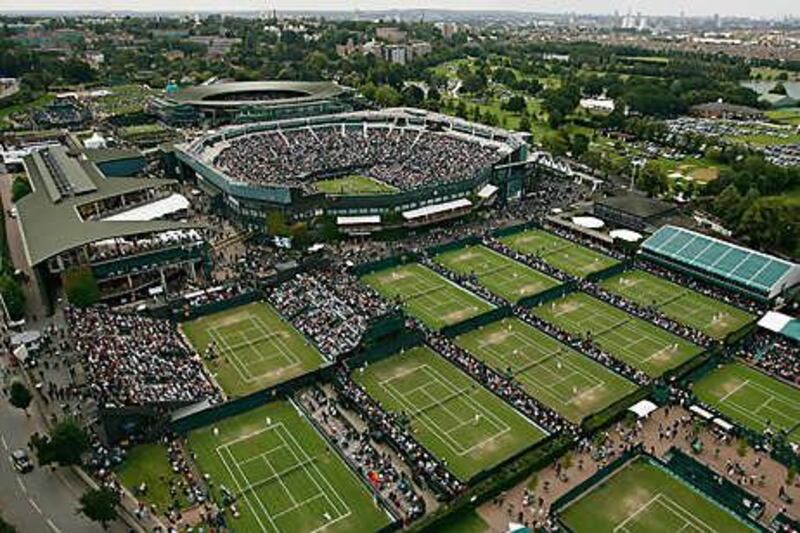From Greece's Temple of Zeus, an ancient shrine that greeted participants at the first Olympic Games in 776 BC, to the Roman Coliseum, site of centuries-old battles between man and beast, Europe is full of sporting history. England, birthplace of the beautiful game and the gentleman's game and one of Europe's most active countries in its role as a continental sporting powerhouse, is also home to possibly the most exclusive sports venue on earth.
Founded in 1868, the All-England Lawn Tennis and Croquet Club in Wimbledon, south London, is a private-members club that is as much steeped in tradition as it is soaked in history. With only 375 members - induction offered by invite and only after laborious scrutiny - the All-England Club is stringent when it comes to respecting its genteel reputation. "We do stick with tradition here; we haven't ever lowered our standards," said Angela Barrett, who became a club member after winning the venue's annual championships in 1961.
The Championships at Wimbledon is the oldest major in tennis, dating back to 1877. But regardless of status - an amateur member playing on a wintry February morning on any of the club's 33 courts, or a professional, such as Roger Federer, competing in the game's only grass grand slam in front of 15,000 spectators - rules dictate that, in a quest for elegance and formality, only white clothes will be worn.
Such is Wimbledon's penchant for purity that Jimmy Connors, the American former world No 1 who triumphed twice at the All-England in 1974 and 1982, once joked that "New Yorkers love it when you spill your guts out there. Spill your guts at Wimbledon and they make you stop and clean it up". Despite the International Tennis Federation's introduction of yellow balls in 1972, the All-England refused to veer from its traditional white balls for a further 14 years. The venue was also "whites only" until 1951 when the American Althea Gibson became the first black tennis player to compete after being invited to that summer's championships. In 1956, Gibson and Angela Buxton teamed in doubles to become the tournament's first black and Jewish champions, respectively.
Certainly, the All-England Club has played host to the best tennis players in the world for a very long time. Eric and William Renshaw, the British twins, won 13 titles - at singles and doubles - between 1881 and 1889. Norman Brookes, the Australian, became the first men's winner from overseas, in 1907. He was victorious again seven years later and only two Brits - Arthur Gore in 1908 and 1909, and Fred Perry in 1934, 1935 and 1936 - have won on Wimbledon's finely manicured lawns since.
To infer that the 450,000 spectators who annually fill the All-England stands during the two-week tournament have had little to cheer about, however, would be as true a statement as proclaiming Pete Sampras, Wimbledon's record title-holder in the men's singles - with seven wins between 1993 and 2000 - was an average player. Bjorn Borg's memorable duel with John McEnroe in the 1980 men's singles final is considered by many to be one of the enthralling matches in tennis history as well as one of the great events in the history of sport. The fourth-set tie-break was so fiercely fought that it lasted 22 minutes and saw 34 contested points, a final record that still stands. McEnroe, an energetic but temperamental 21-year-old, was making his debut in a Wimbledon final and was forced to save five match points before eventually closing out 18-16. However, Borg rallied to win the fifth set 8-6 and secure a quintet of consecutive titles at the All-England.
The match was considered the tournament's greatest until two years ago when Federer and Rafael Nadal, the world's two top-ranked players, faced off in the 2008 final. Again Centre Court was the setting and again the match ended with long-standing records broken. One year before the venue installed its retractable roof, Nadal, the Spaniard, raced to a two-set 6-4, 6-4 lead before rain stopped play during the third with Federer leading 5-4. Eighty minutes later and the Swiss maestro was back on the court and battling for his life. Federer fought back to win the next two sets in tie-breaks, 7-6 (7-5), 7-6 (10-8).
More rain resulted in a further half-hour delay before the two players returned to continue their duel. Under a darkening sky with the heavens threatening to open and Wimbledon rules dictating that no tie-break shall be played on the fifth set of a final, Nadal took the final set 9-7 to secure his first major championship outside of Roland Garros. Even without the rain delays, the match lasted four hours and 48 minutes, making it the longest final in the All England's long and illustrious history. gmeenaghan@thenational.ae
2. Camp Nou, Barcelona ? With a 98,787-seater capacity, the home of FC Barcelona is the largest football ground on the continent. 3. St Andrews, Scotland ? The Old Course at the Royal and Ancient Golf Club is the world's oldest course and still as demanding as its first Open in 1873. 4. Lord's, London ? The "home of cricket" dates to 1814, has held more than 100 Tests and witnessed greats like WG Grace, Don Bradman and Gary Sobers. 5. Olympic Stadium, Berlin ? Built for the infamous 1936 Olympics; site of football World Cup matches in 1974 and 2006, including the '06 final. 6. Alpe d'Huez, France ? The lofty (1,860m) ski resort is the finish line for a gruelling Tour de France stage used almost every year since 1952. 7. Circuit de Monaco - Formula One's first (1929) and most glamorous street race, through and around Monte Carlo and La Condamine. 8. Aintree Racecourse, England ? The Merseyside track opened in 1829. It is home to the Grand National, one of the world's great horse races.





